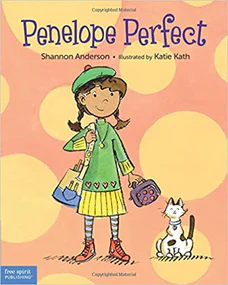Penelope Perfect
A Tale of Perfectionism Gone Wild
Written by Shannon Anderson
Illustrated by Katie Kath
48 pages
•
Published 2015 (Free Spirit Publishing)

Recommended Age Range: 1st grade through 3rd grade.
Publisher's Summary:
When Penelope oversleeps, her daily routine gets thrown for a loop. From wearing mismatched socks to receiving her first-ever “B,” will “Penelope Perfect” survive this imperfect day? This encouraging story told in cheerful rhyme will speak to kids who deal with perfectionism or other forms of anxiety.

Dr. Annie's Takeaways
Recommended for: Children who get stuck in perfectionism will likely benefit from this book’s reminder that imperfection, although scary at first, can be freeing. Kids with super high standards for themselves or who get anxious when things don’t go according to plan may find relief in the balance Penelope strikes when she lets herself “just be Penelope” rather than Penelope Perfect.
Would a child like it? A child who is struggling with perfectionism might really connect with Penelope and her journey. It’s perhaps not totally the most engaging story, but it’s cheerful and kind and a non-threatening introduction to what can be a sensitive subject for children.
Evidence-Based Practices:
Exposure
Tone: Upbeat, joyful
Story Quality: This is a sweet story told in rhyming verse about a girl who wants everything to be just so and according to plan. She wakes up at 5 a.m. to complete her morning routine, stays in at recess to rewrite her notes so they aren’t messy, and stays up late every night double checking her to-do list. When her alarm doesn’t go off one morning and she has to go to school without completing her morning routine, she’s initially horrified and “just know[s] this will be a bad day.” After a low point of feeling like she might cry, she laughs instead: “Why do I feel so giddy? Something strange is happening to me. My wrinkled clothes are so comfy. And my messy hair makes me so free.” She then realizes that she can go to recess and that it’s possible to balance finishing her obligations and letting herself have fun. Her emotional journey–from tightly wound, to losing her composure, to realizing that there is freedom in letting go–is believable and has some depth, especially for a cheerful, rhyming story like this.
Illustrations: Colorful, expressive watercolor illustrations that are a exaggerated in a cartoony way.
Representation: Penelope is a biracial girl–she has a Black mother and a White father. Her family lives in an apartment in a row of attached homes. Penelope’s teacher is a Black woman, and her classmates are a racially diverse group of boys and girls.
Psychological Practices: A child who relates to Penelope will likely initially be horrified with her when she oversleeps and things don’t go according to plan, and they will feel her relief that nothing bad happens when she doesn’t follow her routine; in fact, she has a lot of fun and still has time to finish her homework. Therapists might use this book as an introduction to discussing a perfectionism-related exposure hierarchy
. Penelope concludes, “I’ve learned not to make life a checklist. That doesn’t mean that I’m lazy. It’s alright to go with the flow sometimes. And not make myself so crazy…They called me Penelope Perfect. That was once who I wanted to be. But now I think it’s better to just be Penelope.”
Concerns: At the end of the book Penelope says, “I’ll still try my best in all I do.” A lot of children get stuck on this idea of needing to try their best in all they do, which can actually be paralyzing and totally overkill a lot of the time! Really it’s better to try one’s best sometimes when it matters and not at other times when it doesn’t, and it’s important for children to learn to make this distinction.
